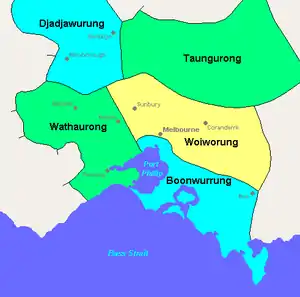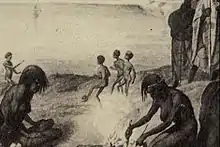Woiwurrung–Daungwurrung language
Woiwurrung (sometimes spelt Woiwurrong, Woiworung, Wuywurung) and Daungwurrung (Taungurong, Dhagung-wurrung, Thagungwurrung) are an Aboriginal language of the Kulin Nation of Central Victoria. Woiwurrung was spoken by the Woiwurrung and related peoples in the Yarra River (Birrarung) basin, and Daungwurrung by the Taungurung people north of the Great Dividing Range in the Goulburn River Valley around Mansfield, Benalla and Heathcote. They are often portrayed as distinct languages, but they were mutually intelligible.[3] Ngurai-illamwurrung (Ngurraiillam) may have been a clan name, a dialect, or a closely related language.[4]
| Woiwurrung–Daungwurrung | |
|---|---|
| Region | Victoria |
| Ethnicity | Woiwurrung, Wurundjeri, Taungurung, ?Ngurelban, etc. |
| Dialects |
|
| Language codes | |
| ISO 639-3 | Either:wyi – Woiwurrungdgw – Daungwurrung |
| Glottolog | woiw1237 |
| AIATSIS[1] | S36, S37 |
| ELP | Woiwurrung[2] |
 The five Kulin nations. Woiwurrung proper is in yellow, Daungwurrung (Taungurung) is in the northeast in green. | |


Phonology
The following is the Woiwurrung dialect:
| Peripheral | Laminal | Apical | ||||
|---|---|---|---|---|---|---|
| Bilabial | Velar | Palatal | Dental | Alveolar | Retroflex | |
| Plosive | b/p | ɡ/k | ɟ/c | d̪/t̪ | d/t | ɖ/ʈ |
| Nasal | m | ŋ | ɲ | n̪ | n | ɳ |
| Lateral | l | ɭ | ||||
| Rhotic | r | ɽ | ||||
| Glide | w | j | ||||
It is not clear if the two rhotics are trill and flap, or tap and approximant. Vowels in Woiwurrung are /a e i o u/.[5]
Pronouns
In the case of the Woiwurrung pronouns, the stem seems to be the standard ngali (you and I), but the front was suffixed to wa-, so wa+ngal combines to form wangal below.[6]
| Person | Singular | Dual | Plural | ||||||
|---|---|---|---|---|---|---|---|---|---|
| Woi. | IPA | Eng. | Woi. | IPA | Eng. | Woi. | IPA | Eng. | |
| 1st Inc. | Wangal | [wa.ŋal] | We two (you) | Wanganyin | [wa.ŋa.ɲin] | We (& you) | |||
| 1st Exc. | Wan | [wan] | I | Wangan | [wa.ŋan] | We two (not you) | Wanganyinyu | [wa.ŋa.ɲi.ɲu] | We (not you) |
| 2nd | Warr | [war] | You | Wabul | [wa.bul] | You two | Wat gurrabil Wat gurrabilla Wat balak Wat wurdundhu |
[wat ɡu.ra.bil] [wat ɡu.ra.bil.la] [wat ba.lak] [wat wu.ɖun.d̪u] |
You |
| 3rd | Munyi | [mu.ɲi] | He/She/It | Munyi gurrabil | [mu.ɲi ɡu.ra.bil] | Those two | Malu gurrabila | [ma.lu ɡu.ra.bi.la] | They |
Other vocabulary
- Bik = land, country
- Boorondara = shade, darkness, night (origin of the name of the City of Boroondara)
- Nyilum bik = poor soil / hard land (origin of the name of Nillumbik Shire)
- Wominjeka = hello / welcome (womin = come, je [dji] = asking to come, ka = purpose)
- yabber = to talk (this word, with the same meaning, has made its way into informal English)[7]
- Yarra = flowing, (also means "hair"). Is thought to have mistakenly given to the Yarra River (which was actually called Birrarung by the local indigenous peoples) by an early settler who asked a boy what it was called, who was confused and answered "it is flowing".
Number and sign system
A numbering system was used when Wurundjeri clans sent out messengers to advise neighbouring clans of upcoming events, such as a ceremony, corroboree, a challenge to fight or Marn grook ball game. Messengers carried a message stick with markings to indicate the number and type of people involved and a prop to indicate the type of event, such as a ball for a Marn grook event. The location of meeting was spoken, but neighbouring clans might not use the same language, so a sign language was used to indicate the number of days in the future when the people should assemble. The number was indicated by pointing to a location on the body from 1 to 16. After 16, at the top of the head, the count follows the equivalent locations across the other side of the body. [8]
| Numeral | Spoken number | Sign of the number | Literal meaning |
|---|---|---|---|
| 1 | bubupi-muningya | little finger | child of the hand |
| 2 | bulato-ravel | third finger | little larger |
| 3 | bulato | middle finger | larger |
| 4 | urnung-meluk | forefinger | urnung means a direction, meluk means a large grub found in some eucalypti |
| 5 | babungyi-muningya | thumb | the mother of the hand |
| 6 | krauel | wrist-joint | |
| 7 | ngurumbul | the divergence of the radial tendons | a fork |
| 8 | jeraubil | the swelling of the radial muscles | |
| 9 | thambur | the inside of the elbow-joint | a round place |
| 10 | berbert | biceps | the ringtail possum and also the name of the armlet made from the pelt of that animal, worn on the bicep during festive occasions |
| 11 | wulung | shoulder-joint | |
| 12 | krakerap | the collar-bone | the place where the bag hangs by its band |
| 13 | gurnbert | the neck | reed necklace, or place where the reed necklace is worn |
| 14 | kurnagor | the lobe of the ear | the point or end of a hill, or of a spur or ridge |
| 15 | ngarabul | the side of the skull | a range or the ridge of a hill |
| 16 | bundial | top of the head | the cutting-place, the place where the mourner cuts himself with some sharp instrument, from budagra meaning to cut |
| 17+ | From the top of the head, the count follows the equivalent locations across the other side of the body. 17 is the other side of the skull. | ||
See also
Further reading
- Blake, Barry (1979). Handbook of Australian languages. Canberra: Australian National University Press. ISBN 0195530977.
- Morrison, Edgar (1981). The Loddon Aborigines: tales of old Jim Crow. Daylesford, Vic.: Daylesford and District Historical Society.
References
- S36 Woiwurrung–Daungwurrung at the Australian Indigenous Languages Database, Australian Institute of Aboriginal and Torres Strait Islander Studies (see the info box for additional links)
- Endangered Languages Project data for Woiwurrung.
- Barry Blake 1991: 31
- S83 Ngurai-illamwurrung at the Australian Indigenous Languages Database, Australian Institute of Aboriginal and Torres Strait Islander Studies
- Hercus (1969).
- Barry J. Blake. 1991 Woiwurrung In: The Aboriginal Language of Melbourne and Other Sketches, ed. R. M. W. Dixon and Barry J. Blake, pp. 31–124, OUP, Handbook of Australian Languages 4
- Oxford Dictionary of English, p 2,054.
- Howitt, Alfred William (1901). . Native Tribes of South-East Australia. McMillan. p. 701 – via Wikisource.
External links
| Look up Woiwurrung in Wiktionary, the free dictionary. |